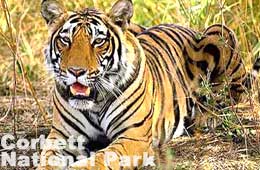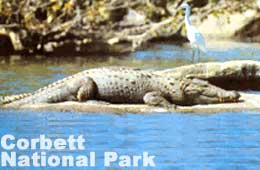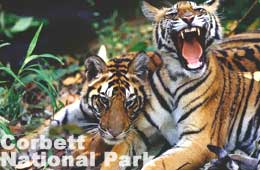|
On your India wildlife tour visit the Corbett National Park, India's first national park and the first wildlife sanctuary. This wildlife sanctuary is located in the foothills of the Himalayas and is home to a variety of flora and fauna.

The national park is famous for its wild population of Tigers, Leopards and Elephants. In 1936, the park was established in as the Hailey National Park. The Project Tiger first started here, as it supports a variety of vegetation making it the ideal habitat for the Tiger and its prey.
Once a popular hunting ground of the British, this 201 square mile park was named in honor of the late Jim Corbett, the legendary hunter-naturalist turned author and photographer who most of his years in this area and contributed in setting up the this park. With the help of the World Wildlife Fund, Project Tiger was launched in Corbett National Park in 1973 and this park was one of the first such tiger reserves in the country.
The region around comprises of hilly and riverine areas, temporary marshy depressions, plateaus and ravines. The lower areas are almost completely populated by Sal trees. In the Jim Corbett National Park are found 110 tree species, 50 mammals species, 580 bird species and 25 reptile species.
Corbett is a haven for Tigers as well as its prey, which include four kinds of Deer, Wild Boar and some lesser-known animals. Leopards are mostly found in the hilly areas of the park. Some nocturnal cats found here are the Leopard Cat, Jungle Cat and Fishing Cat. Sloth Bear is found in the lower regions of the park while the Himalayan Black Bear is seen in the higher hills only. The Dole or Wild Dog, though they can be seen in the southern areas of the park along with the Jackal.
|
|
Some of the smaller residents of the park are Himalayan Palm Civet, Indian Gray Mongoose, Common Otter, Blacknaped Hare and Porcupine. Elephants are among one of the main attractions of Jim Corbett Park. Along the Ramganga River shores, one can spot the long-snouted, fish-eating Gharial Crocodile and the 'Mugger' Crocodile. Also seen on the rocky hillsides is the Ghoral or Goat Antelopes. The Langur and Rhesus Monkeys are well distributed through out the park and warning the whole Jungle with alarm calls when they see either a Tiger or Leopard from tree-top perches.
The main feature of this ridged valley is the Ramganga River, running broadly west by south west, the catchment streams of which dissect the land into numerous little ridges and ravines.
 The center of tourist activity in the park always was and continues to focus at Dhikala, at the heart of the focus at Dhikala, at the heart of the core area, where substantial residential accommodation has been built along one end of a large grassy plateau perching precariously at the very edge of the sheer cliff bordering the Ramganga reservoir.
The center of tourist activity in the park always was and continues to focus at Dhikala, at the heart of the focus at Dhikala, at the heart of the core area, where substantial residential accommodation has been built along one end of a large grassy plateau perching precariously at the very edge of the sheer cliff bordering the Ramganga reservoir.
At Dhikala forest lodge you will find a good range of rooms, food and other provisions. There is a library, a cafeteria, machaans and elephant rides. The lodge provides sparse huts built in small clearings amidst thick jungles. You can get the feel of adventure while staying at this lodge. Deer straying into the compounds, predators calling in the vicinity through the night and birds making an incessant racquet morning and evening.
There is also a choice of Resorts to choose from, all located along the main Ramnagar-Ranikhet road bordering the eastern edge of the park. Budget tourists are limited to accommodation in Ramnagar, the nearest town. Although Dhikala is out of bounds, day-trippers are not entirely excluded from the park. The Amdanda gate accessing Bijrani is open to nonresident guests, up to 100 per day on a first come first serve basis, and while Bijrani does not have the natural beauty of Dhikala, there is very little which is lacking in terms of facility or wildlife.
As with the rest of the country, there are three well-defined seasons at the Corbett National Park-winter from November to February, summer from March to June and the rainy season the rest of the year. The roads in the park are good for cars but only just: it is all shock absorber breaking second gear 20 kilometers per hour work and the rains make the park completely inaccessible. Corbett is closed between 15th June to 15th November.
While on tour to the Corbett National Park you can visit the Dudhwa Tiger Reserve, lies in the sub-Himalayan terai of Lakhimpur Kheri district of Uttar Pradesh at the Indo-Nepal border. The sanctuary covers an area of 12 square kilometers, and was finally declared a National Park covering 613 square kilometers in 1977. In 1988, when Dudhwa was declared a Project Tiger Reserve, the area was further enlarged to 811 square kilometers.
The establishment of the Dudhwa reserve was initially taken up for the preservation of a rare species of deer-the swamp deer or barasingha. Presently there are about 1,200 swamp deer in the entire sanctuary. In spite of intensive conservation and protection has gone down by more than 30 per cent during the last four years. The area is luxuriant and lush green all over; with Sal forests are interspersed with numerous grasslands, swamps and lakes. The grasslands are flush with grasses, which grow to more than 15 feet in height.
Dudhwa is popular for its Great Indian one-horned rhinoceros. Once abundant in the region, had been hunted down to the last animal in the State by 1878. By 1900 only a few hundred Indian rhinos were left in small, isolated pockets in Assam, West Bengal and Nepal. Fearing there wipe out due to natural disasters or epidemics, it was decided to distribute them over a wider area. Dudhwa was found suitable for trans-location, thus creating another pocket for this endangered species.
 Fact File
Fact File
Getting There: The Corbett National Park is at a distance of about 300kms from Dhikala, 145kms from Lucknow and 51kms away from Ramnagar.The route to be followed while traveling is via Hapur-Moradabd-Ramnagar. The route from Lucknow spans Bareilly-Kichha-Rudrapur-Doraha-Kashipur. Bijrani is 9 kilometers from Ramnagar.
Accommodation: The Corbett National Park is close to many minor Forest Rest Houses, situated at Khinanauli, Sarpduli, Gairal, Sultan, bijrani and Kanda. Tourists also have a range of resorts to choose from, all located along the main Ramnagar-Ranikhet road bordering the eastern edge of the park. These are all high-end budget resorts but even for the budget tourists, there are adequate options available in Ramnagar, the nearest town.
| 




